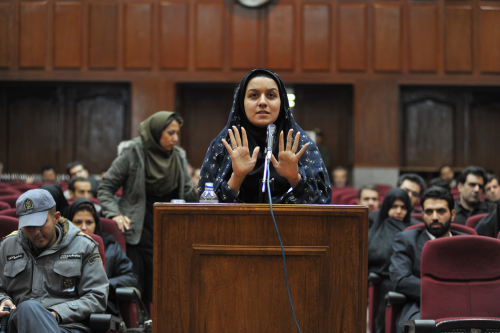08/08/2023
Reyhaneh Jabarri was an interior designer living in Tehran, in July 2007. At the age of nineteen, Jabarri was sketching the interior of a client’s apartment. Suddenly, Morteza Sarbandi locked the door and attempted to rape her, but she stabbed him out of self-defense. Sina Ataeian Dena and Steffi Niederzoll’s documentary follows the tragic consequences and punishment of Reyhaneh Jabarri who was then arrested for murder, despite having acted out of self-protection. She was given a death sentence where her fate, which was put on hold for seven years, was subject to another family’s decision, otherwise known as Blood Revenge.
Explored through the narrative and encapsulated through the production of the film, the documentary highlights the meaning of protest, the weight of Blood Revenge, and the silencing forces of the Iranian justice system.
Although Reyhaneh rarely appears in the documentary, we were able to understand the contours of her resilient character through her diary and interviews with others: Reyhaneh was creative, intelligent, family-oriented, and fun-loving. Her inmate and friend in the prison described her as “the matriarch” because, despite her young age of only nineteen, she evolved into a maternal figure. The prison taught Reyhaneh that these women who had been previously labeled as “an underclass” were often just framed as threats by the system.
Over the seven years, Reyhaneh’s mother, Shole Pakravan, was in conversation with Jalal, the son of Sarbandi. Jalal said if she took back the accusation of rape they would free Reyhaneh. However, despite this ticket to freedom and her mother’s begging for her release, Reyhaneh refused to take back her claim and chose truth and protest over submission and ‘freedom’.
Shole Pakravan’s role represented the endurance of motherhood. From the moment Reyhaneh was arrested, the Iranian media attempted to pin her as a serial killer. However, Reyhaneh’s parents did not question her action and their instinctive love carried their hope for her release over the seven years. Pakravan was in conversation with Jalal over the seven years, begging for peace and asking for him to take her instead.
Her dedication fuelled an international campaign that made Reyhaneh an international symbol. As an activist, Pakravan transformed the national depiction of her as a killer into the international representation of her as a symbol for protest; as a mother, she cried for Jalal until her last moment saying she would “love him like a son” if she was freed. Although Reyhaneh did not receive justice, Shole Pakravan’s activism for women’s rights continues in Germany.
The film itself emulates this protest and the quest for liberation. It was made through smuggled footage and diaries which documented the fringes of Iran: the prison system. The structure of the filming puts the viewer into the perspective of the mother. Although we knew that Reyhaneh’s fate was most probably execution, the skilled curation gave us false hope that Reyhaneh would survive the unjust prison system, the same kind of hope that motherly love allows for.
We, in the audience, waited until the end of the credits, as if hoping for some sort of happy ending. There is of course no miracle plot twist; the lives of these women have been twisted by the press or worse, executed without recognition. However, those of us sitting in the Lumbardhi cinema now know Reyhaneh’s story but more than that we now know the story of all these women. They may have been forgotten by society, but their memories were brought to life here in the artistic city of Prizren.
By: Lily Sheldon



